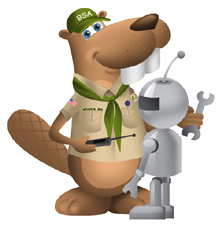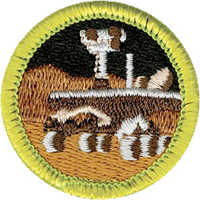Robotics


Resources
- Robotics Class Preparation Page
- Robotics Workbook
- Scoutmaster Bucky Robot Engineering Notebook
- Scoutmaster Bucky's Merit Badge Advancement Quick Reference
- Scoutmaster Bucky's Acknowledgement Form
Related
Robotics Requirements Current Scouts BSA requirements
as of May 26, 2025
as of May 26, 2025
1.
Safety. Do each of the following:
a.
Explain to your counselor the most likely hazards you may encounter
while working with robots and what you should do to anticipate,
mitigate and prevent, and respond to these hazards. Describe the
appropriate safety gear and clothing that should be used when working
with robotics.
b.
Discuss first aid and prevention for the types of injuries that could
occur while participating in robotics activities and competitions,
including cuts, eye injuries, and burns (chemical or heat).
2.
Robotics Industry. Discuss the following with your counselor:
a.
The kinds of things robots can do and how robots are best used today.
b.
The similarities and differences between remote-control vehicles,
telerobots, and autonomous robots.
c.
Three different methods robots can use to move themselves other than
wheels or tracks. Describe when it would be appropriate to use each
method.
3.
General Knowledge. Discuss with your counselor three of the five
major fields of robotics (human-robot interface, mobility, manipulation,
programming, sensors) and their importance to robotics development.
Discuss either the three fields as they relate to a single robot system OR
talk about each field in general. Find pictures or at least one video to
aid your discussion.
4.
Design, Build, Program, Test. Do the following:
a.
With your counselor's approval, choose a task for the robot or robotic
subsystem that you plan to build. Include sensor feedback and
programming in the task. Document this information in your robot
engineering notebook.
b.
Design your robot. The robot design should use sensors and programming
and have at least 2 degrees of freedom. Document the design in your
robot engineering notebook using drawings and a written description.
c.
Build a robot or robotic subsystem of your original design to
accomplish the task you chose for requirement 4a.
d.
Discuss with your counselor the programming options available for your
robot. Then do ONE of the following options.
1.
Option 1. Program your robot to perform the task you chose
for your robot in 4a. Include a sample of your program's source
code in your robot engineering notebook.
2.
Option 2. Prepare a flowchart of the desired steps to
program your robot for accomplishing the task in 4a. Include
procedures that show activities based on sensor inputs. Place this
in your robot engineering notebook.
e.
Test your robot and record the results in your robot engineering
notebook. Include suggestions on how you could improve your robot, as
well as pictures or sketches of your finished robot.
5.
Demonstrate. Do the following:
a.
Demonstrate for your counselor the robot you built in requirement 4.
b.
Share your robot engineering notebook with your counselor. Talk about
how well your robot accomplished the task, the improvements you would
make in your next design, and what you learned about the design
process.
6.
Competitions. Do ONE of the following.
a.
Attend a robotics competition and report to your counselor what you saw
and learned about the competition and how teams are organized and
managed.
b.
Learn about three youth robotics competitions. Tell your counselor
about these, including the type of competition, time commitment, age of
the participants, and how many teams are involved.
7.
Careers. Name three career opportunities in robotics. Pick one and
find out the education, training, and experience required for this
profession. Discuss this with your counselor, and explain why this
profession might interest you.

